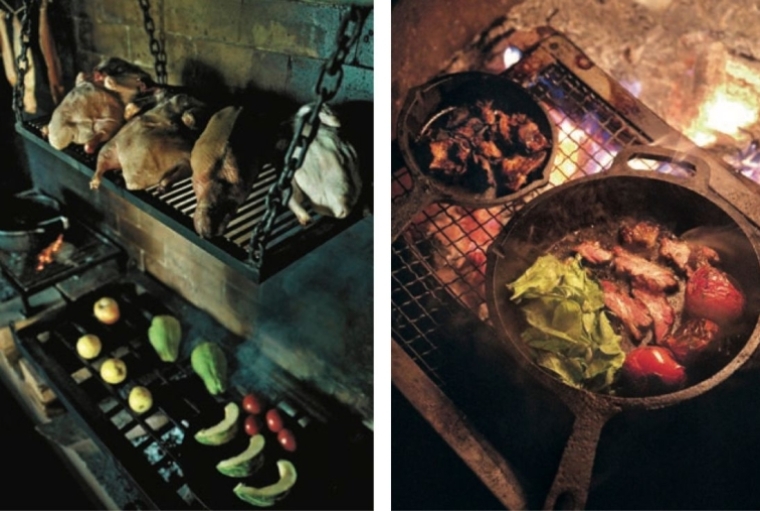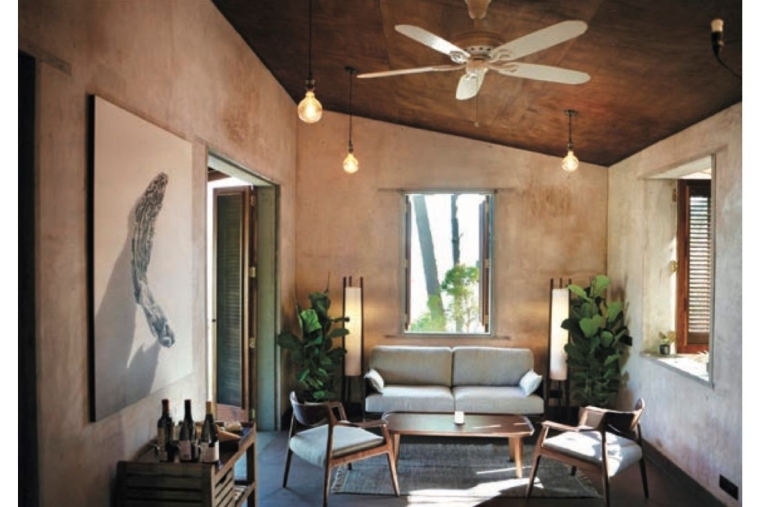

He brought us India’s first tasting menu format. Now, he’s bringing us home.
Prateek Sadhu, a name synonymous with championing India’s culinary outlook, re-enters the conversation by presenting a concept so off the wall, or the mountain in this case, that diners have no choice but to plot their way to join his newest adventure - Naar. To call it a sixteen seat restaurant is a discredit to the ecosystem. A multivenue operation, featuring both a sexy salon for pre-meal libations and a quaint but courageous in-kitchen dining room that sits on a cliff, a reservation to Naar is best introduced as an itinerary.

The passage to Naar is a culinary commitment. Situated within the property of the coveted Amaya resort, the concept demands you to take planes or trains and certainly automobiles for a seat at the table. But once you arrive the voyage does not end, as a meal at Naar is a journey in itself. A journey through The Himalayan Belt, as told by Prateek.
But the chef will tell you that he is not alone on this quest to bring Himalayan home recipes to the forefront for as he says, it takes a village. Describing his twenty one person team of nomads, who both work and live the concept, Prateek and his crew maintain a culinary program that is so intentionally cyclical that we could easily call it sustainable.
He would ask us to say otherwise. “Sustainability, what does it mean? It’s a buzz word. Everyone is saying it but do they know what it means? For us, it’s about being as conscious as we can,” he explains, while standing amidst rows of sprouting spring alliums with Himalayan winter citrus hanging in his immediate view.
A tagline for many, the notion of farm to table is inherent to the Naar concept with their living, working farm that is as much a part of the restaurant as the food it produces. Ashes from Prateek’s full flame grill are mixed into the soil as a natural antiseptic while the what-could-be-waste rinds from the zippy gal gal, one of the many varieties of hill citrus, are used as a beautiful vessel for their mid-meal course.

An ode to the Himachaly people’s winter salad: nimbu sahnd, a pungent mash of the segments and house bhang, or hemp seed is topped with a demure foamed yogurt and finished with chilli salt. Talk about a complex set of flavours that come together in a harmonious few but very fine bites. Just as visually appealing, the rind is surrounded by a bouquet of winter flora, the dish is stunning but not as bloomful, apparently, as what comes next season.
“I’ll be serving a dish that will literally be a bouquet,” Prateek describes with a smile to his eyes in what we can only imagine will be the most beautiful of arrangements. The beverage program plays an equally aware approach, with jars of regenerated bits of charred potato and winter pomelos fermenting away to make their triumphant presence of winter ingredients in what will soon be spring menu cocktails. In a single sip of the house made amaro, whose hue can be best described as that blood orange setting sun, one knows that their specific spot in the Himachal Belt fully informs their menu that changes seasonally with two additions to the formative four.
“In this part of the world, in the mountains there’s legit six seasons. October through December is pre-winters, then January, February is winter time. Then we move onto spring and honestly when I say this, you know when it’s spring, it’s really spring. There’s flowers all around. There’s an apple bloom happening, there’s cherry bloom happening, there’s peach bloom happening. It’s just blooming,” he describes while gesturing to the stone fruit tree already boasting its premature purple buds.
True pride for his menu comes from the sincerity that what happens in the environment surrounding Naar actually informs the offerings. It could be curious, almost critical, that the two fish courses served on the winter menu both featured trout, rather than a more diversified set of aquatic ingredients. But the simple reality is that trout is the fish available in the belt; the fish that marked the meals of Prateek’s childhood.
Described as a dirty toast, the meal’s first trout offering features a barely cooked filet, just kissed on the grill, atop a house made toast slathered in a drippy emulsion of mustard oil and left over trout meat. While the cook on the trout is nothing short of sophisticated, the intentionally filthy composition imposes that fine dining should be fun. A true tale of Prateek, the chef, whose mischievous disposition can hardly be masked by his conscious culinary craft.
The amusement continues from there with the uncensored hip hop playlist bumping throughout the dining room, as a much more composed dish than the former arrives, featuring the second seasonal trout offering. Contrary to the quick peck of the first, the fish here is slowly smoked on the same grill and nestled into a fresh malu leaf alongside green peas from the poly house and phap, a natural yeast typically used to distill the local liquor of chaang, that provides the same unctuous umami as the finest of misos.
Through each course the tastes and techniques are clearly evident but, and almost equally important for the diners, the knowledge served throughout is inherent to the concept. While Prateek makes his spritely tour of the dining room throughout the meal, code switching from chef in the kitchen to tableside tour guide, the team at Naar does very much the same. Bartenders from the salon are seen garnishing dishes in the kitchen, while attending to wine service in between and each member of the crew delivers dishes with the level of knowledge and pride only plausible when they are contributing from inception to existence.
As Prateek’s musings of using food as the medium to deliver the unsung recipes of his native Himalayan Belt are materialising in each intentional menu at Naar, it would be remiss not to acknowledge that his thoughtfulness is born from lifelong necessity.
A Kashmiri refugee, Prateek’s upbringing featured a symbiotic relationship between movement and preservation, where the family was forced to relocate and adapt to surroundings while attempting to uphold their roots. According to his mom the best ways were through language and food.
As the family transpired from their hometown of Baramulla to refugee camps to eventually the outskirts of Delhi, his mother maintained her Kashmiri menus, serving family favourites like crispy oolu churme, currently served as a pre meal snack in the Salon at Naar. Sinfully crispy on the outside with the sultry, smooth mouthfeel of perfectly whipped potatoes on the inside, the savoury bite is topped with a dollop of fresh cream and studded with salty pops of roe, trout of course.
When his childhood aspirations of becoming a pilot took a different flight path to culinary courses in India and eventually to the Culinary Institute of America in Hyde Park New York, Prateek has certainly travelled tastefully. As his journeys have included stints in some of the world’s most coveted kitchens with the greatest names in fine dining, it is without a doubt his journey back home to the Himalayas, is the most reflective of them all.
Although he claims his preservation of language comes through only in his commitment to speak to his mother daily in their native Kashmiri, the narrative woven throughout his menu showcase a more actualised representation of not just the food but how he uses multiple languages to collect recipes to deliver on his theory that, ‘the future of Indian food really lies on every region to tell their own stories. I think that’s very important. There’s a lot of amazing people doing some really incredible work in this country and that’s the future.’
While his concept is a labour of Prateek’s love for Himachal, a representation of his heritage cuisine, the chef puts his promises into practice by working with others from the region to share the spotlight. North of Naar, from the Mashobra valley, Prateek engages with the
Indo-French wife and husband team from Amiksa Cheese to produce custom offerings on the restaurant’s signature cheese cart. Following French cheese making practice with products from the surrounding hills, the current offerings at Naar include a lactic cow’s milk wheel, devil- ishly coated in ash from his grill.
The cheese course itself represents learnings from his Western experiences in a way that is so deliberately desi. And even in this attempt to present what is inherently Indian, Prateek pushes the narrative one step further.
‘The idea is to change perceptions about what Indian people think of Indian food. Right now on the menu we have gyumas which is a pure blood sausage and sandarkala which are noodles from Sundarkala. When you talk about all these things, noodles, blood sausage, people don’t associate these things with India.’ His countless research and development treks through the mountains illuminate these associations in a method that is so authentic Indian and so very reliant on language.
As he uncovers heirloom species like the orange studded shrubs known as a ‘Sifat’ in Ladhak’s Turtuk, Prateek for- ages not only for heirloom ingredients; he forages for friends. Relying on his own knowledge of language and engaging others with aptitude for alternative tongues, Prateek charters the unmap- pable villages, scattered throughout the belt, as he is invited into the homes of the very storied residents to learn, first hand, how to prepare his own take on Himalyan homemade fare. If you ask him how he learned to assemble the bloody gyumas, he’ll unabashedly show you videos of a man he met in the village of Gya so you too can see just how the sausage is made. For once you’ve tasted the meaty morsels, hand cut noodles and delicate broth, it would hardly be plausible not to know everything about it.
As the seasons change and the menus take on their new weathered approach, the team at Naar should expect to welcome back repeat diners, regardless of the effort it takes them to get themselves there.
A true dining destination, each moment on the mountain, each moment at Naar is respectfully researched and undoubtedly innovative. However it is the conscious approach and playful characteristics, indicative of Prateek himself, that mark the experience as, most importantly, offering a courageously comforting experience.
Prateek is, after all, inviting us home.
Words Gauri Sarin
Date 08.06.2024